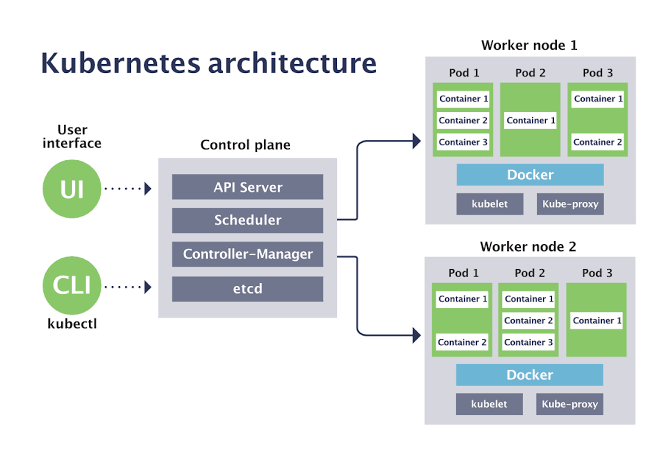
Containers can encapsulate an application into a mobile and easy form to install. Containers are portable and easy to deploy. Kubernetes design is designed to run containerized software. A Kubernetes cluster comprises one control plane with at minimum one working node (typically either a virtual or physical server). The control plane is responsible for two primary responsibilities. It provides Kubernetes API to users through the Kubernetes API through the API server and also manages the nodes that comprise the cluster.
The control plane takes decisions about the management of the collection and is responsive to events in the group.
The smallest execution unit for an application that runs in Kubernetes can be described as the Kubernetes pod, which is comprised of one container or several. Kubernetes Pods run on worker nodes.
Additional Kubernetes Terminology
It’s essential to be aware of the names and roles of the critical K8s components which are part of the control plane or operate via Kubernetes nodes.
The control plane consists of four major components that manage communications, monitor nodes, and monitor the status of a Kubernetes cluster.
- Kube-API server: As the name suggests, it is a Kubernetes API.
- Etc: Key-value storage where all information related to the Kubernetes cluster is kept.
- Kube-controller-manager: This compiles all controller functions of the control plane into a single binary.
- Kube-scheduler: It monitors for new Kubernetes Pods with no assigned nodes and then assigns them to an execution node per policies, resources, and affinity requirements.
A K8s node is composed of 3 main components:
- Kubelet. A tool that helps ensure that the required containers are running within the Kubernetes Pod.
- Kube-proxy. A proxy for networks that runs on every cluster node to keep track of network rules and permit communication.
- Container runtime. This is software that runs containers. The Kubernetes can run any running program which conforms to Kubernetes CRI (Container Runtime Interface).
Other words to know comprise:
- Kubernetes service. A Kubernetes service is a logical abstraction of an entire group of Kubernetes pods with the same objective. It has unique addresses that remain the same, even when pod instances move and disappear.
- Controller: The Controllers confirm that the running condition of the Kubernetes cluster will be the closest it can be to the state you want it to be.
- Operator. Kubernetes Operators allow you to create a domain-specific application, similar to running a book. Automating tasks specific to the application Operators lets you better deploy and manage your applications on Kubernetes 8s.
If you are interested in mastering Kubernetes and its concepts, consider taking Kubernetes Training to enhance your skills.
Advantages of Kubernetes
The Kubernetes platform is now earning popularity due to its a variety of essential benefits:
- Capability. Containers are portable across many environments, from virtual to pure metal. Kubernetes is compatible with the main cloud providers, which means that containers can be run using Kubernetes in various settings.
- Extensibility and integration. Kubernetes can be adapted to work with the existing solutions you depend on, such as monitoring, logging, and alerting and monitoring services. The Kubernetes community functions on a wide range of open-source solutions that work in conjunction with Kubernetes. This creates an expansive and rapidly expanding ecosystem.
- The efficiency of cost. Kubernetes has inherent capacity optimization and automated scaling. The capacity to run tasks in the spots where they can deliver the highest benefit means that your IT expenditure is in your hands.
- Scalability. Cloud-native applications can scale horizontally. Kubernetes uses “auto-scaling,” spinning up more container instances and automatically scaling them out according to the demand.
- API-based. The basis of Kubernetes ‘ REST API. Everything within the Kubernetes environment is controlled by programming.
- Simple CI/CD. CD/CI is a DevOps practice that automatizes the creation of the applications, testing them, and then deploying them in production. Enterprises are merging Kubernetes with CI/CD to build flexible CI/CD pipelines that can dynamically adjust to the demands.
What does Container Orchestration?
Container orchestration automates most tasks involved in running containerized services and workloads, including the processes crucial to the Kubernetes lifecycle of the container, including provisioning, deployment, scaling networking, and load balancing.
Kubernetes vs. Docker
Docker is a platform for software scheduled to develop containerized software, whereas K8s is a tool that automates the process of running containers and cloud-native applications created using Docker and other programs. Many companies use Docker as well as Kubernetes in conjunction.



